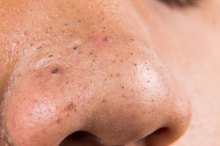What does fact checked mean?
At Healthfully, we strive to deliver objective content that is accurate and up-to-date. Our team periodically reviews articles in order to ensure content quality. The sources cited below consist of evidence from peer-reviewed journals, prominent medical organizations, academic associations, and government data.
The information contained on this site is for informational purposes only, and should not be used as a substitute for the advice of a professional health care provider. Please check with the appropriate physician regarding health questions and concerns. Although we strive to deliver accurate and up-to-date information, no guarantee to that effect is made.
How to Treat Ingrown Hair Scars
Ingrown hairs are caused by the end of a hair becoming caught underneath the skin while it continues growing. The area typically becomes infected and pus-filled, often causing people to try to pick or pop the infected area.
This leads to damage and scarring, leaving behind areas of skin discoloration long after the ingrown hair has healed. Luckily, discolored and scarred skin can be effectively diminished by following a routine that softens the scarred tissue, scrubs away the softened skin and tones the skin with a substance that will increase the rate at which the skin cells turn over.
Apply a non-comedogenic oil to the scarred area to soften discolored tissues.
Non-comedogenic oils can be used on your skin without clogging your pores 3. They dissolve the dirty oils caused by bacteria, hormones and dead skin cells lurking on your skin. Argan oil, hemp seed oil and shea butter are non-comedogenic and emollient, meaning that they can also soften your skin for a supple glow.
How to Do It: Pour 1 tbsp. of non-comedogenic oil into your palm and spread it over the area that is affected by scarring 3. Use your fingers to massage the oil into your skin. Move your fingers in slow, deep, circular movements for three minutes. Place a steaming hot washcloth over the area and leave it there until the washcloth cools down completely. The heat used in this step opens up your pores, allowing the dirt to escape. Use the washcloth to wipe away the remaining oil.
How to Get Rid of Permanent Blackheads
Learn More
Scrub away the softened tissues using a natural and mildly abrasive exfoliant.
Desquamation is the body's natural process of shedding old skin so that new skin and come to the surface. Oily skin prevents this process, trapping dead skin cells and allowing for acne causing bacteria to build up in your follicles. Exfoliation can help to get rid of that old, scarred skin. Baking soda is comprised of smooth, rounded particulates that can scrub off dead, scarred skin without scratching, irritating or scraping the skin, making it a useful exfoliant.
How to Do It: Pour 1 tbsp. of baking soda into a bowl, and mix 1 tsp. of water into it. Spread the baking soda scrub onto the area of skin loosened by the olive oil, and massage it in a circular motion for three minutes. Be careful to avoid the eye area. Rinse off the skin with warm water. Baking soda can be irritating to the skin, so use this method of exfoliation sparingly 2.
Tone the area with a substance high in vitamin C 4.
While citric acid eases the shedding of dead skin cells, vitamin C, or ascorbic acid, boosts skin cell growth. Both are found in lemons and other citrus fruits.
How to Do It: Soak cotton pads in diluted lemon juice and apply the pads to the areas affected by scarring. Allow the lemon juice-soaked pads to remain on the skin for at least 10 minutes, then remove the pads to let the skin dry.
How to Clear Up Ingrown Hairs
Learn More
What Do YOU Think?
Before reading this, did you think that you could use oil to clean skin and remove dead skin cells? Will you be trying any of these methods to get rid of ingrown hair scars? What's your skin care routine? Let us know in the comments section!
Related Articles
References
- The Oil Cleansing Method: Loosening Skin
- Demalogica: the importance of exfoliation
- The Best Organic Skin Care: A List of Non-Comedogenic Facial Oils
- Allure: Want Brighter Skin? Why Vitamin C Is the Answer
- Cleveland Clinic: Skin Care and Cosmetics
- LIVESTRONG.COM: Difference Between Citric Acid and Ascorbic Acid?
- Draelos ZD. "Facial Skin Care Products and Cosmetics." Clinics in Dermatology. 2014 Nov-Dec;32(6):809-12.
- Griffith JL, McCowan NK. "Basic Skin Care: A Pragmatic Approach to Better Skin Using Over-the-Counter Cosmeceuticals." Journal of the Mississippi State Medical Association. 2014 Oct;55(10):316-20.
- Tan KW, Graf BA, Mitra SR, Stephen ID. "Daily Consumption of a Fruit and Vegetable Smoothie Alters Facial Skin Color." PLoS One. 2015 Jul 17;10(7):e0133445.








